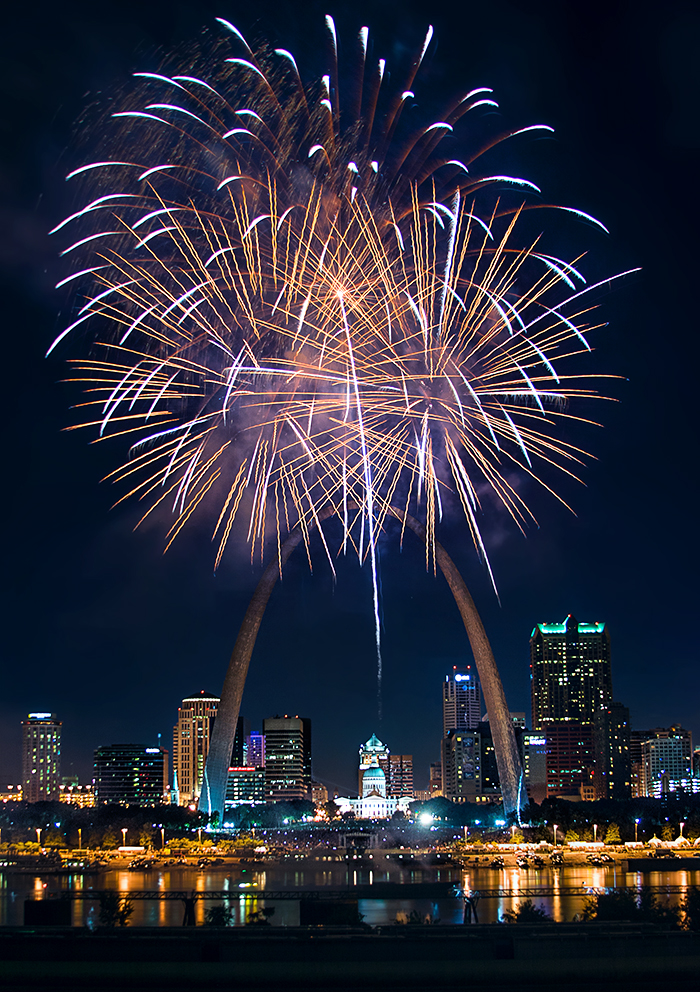
If you haven’t done it before, photographing fireworks might appear difficult. It really isn’t though. As support for that statement, I point you to the image above. I am pretty happy with it, but I took it many years ago, very early in my photo career, with basic entry-level equipment. So this is definitely something you can do, and it shouldn’t cost you anything.
That said, photographing fireworks does require some preparation. In fact, the difference between success and failure is often in that planning. In this article, I will walk you through the steps so that next time you plan to attend a fireworks display you will be ready.
Scout the Location
It is really important to scout the location of the fireworks display beforehand. The best way to do this is simply by arriving early. If you do that, the organizers will already be setting things up so you will gain a sense of how things will be arranged (versus scouting on a prior day when that may not be the case). This is important, not only because you want to get an overall sense of the place, but also because you’ll need to figure out the following:
- Fireworks location: You’ll need to know where they will actually be shooting the fireworks, obviously. That way you can make sure you have a clear line of sight to them.
- Access: It is common at fireworks displays to restrict access to certain areas. You’ll need to see where you can and cannot go.
- Crowds: It is important to understand where the crowds will gather. For one thing, you may want the crowd to be part of the picture. If not, you’ll need to figure out where to set up so there are no people in your way.
- Foreground: An important – but often overlooked consideration – is the foreground of your shots. The subject is obviously the exploding fireworks, and the background is just the black sky. What’s left is the foreground, and it is often the difference between a pedestrian picture of exploding fireworks and something special.
- Set Up: All these factors will give you an idea where to set up your tripod.
If you try to do all these things on the fly, bad things will happen. You’ll be rushed, for one. In addition, all the people gathered for the display will hamper your movement and ability to set up where you want. Get there early and you won’t have those problems.
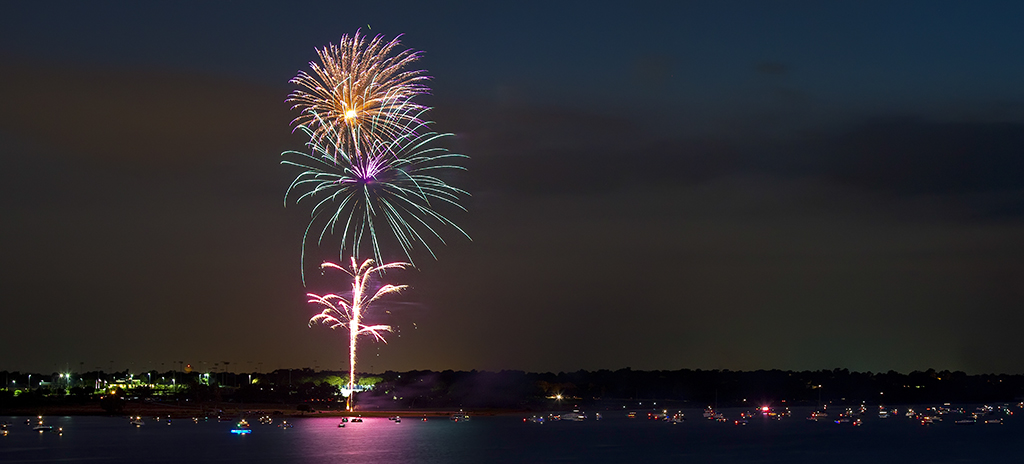
Dial in the Exposure
You will also want to take some time to dial in your exposure as well. There is more to this than just getting a proper exposure level.
The most important consideration is your shutter speed. I find that a good shutter speed for these shots is between 4 seconds and 8 seconds. You can go a little faster or slower if you want, but be careful. If you use a much faster shutter speed, you won’t capture the full explosion of the firework. Even worse, what you do capture will look jagged and unpleasant. On the other hand, if you use a much slower shutter speed, things just won’t show up well in the frame.
Next, set your ISO. As with virtually every situation, you want to use as low an ISO as possible. Because you will be using a rather long shutter speed, you can often get away with using a low ISO. This is important because dark tones such as you will have in your picture lend themselves to digital noise. By keeping the ISO low you will minimize that. Start with an ISO of 100, and only raise it if you need to. That said, I frequently use ISOs of 200 and 400 as well. The point is just to keep it rather low.
Finally, set your aperture. Depth of field is usually not a big consideration in fireworks shots. The background is black and you are usually not trying to capture something immediately in front of you. Therefore, you can safely use a moderate or even large aperture. Start with a default setting of f/8 and adjust from there. Don’t be afraid to change the aperture a lot though. In fact, this is the control where you have the most latitude.
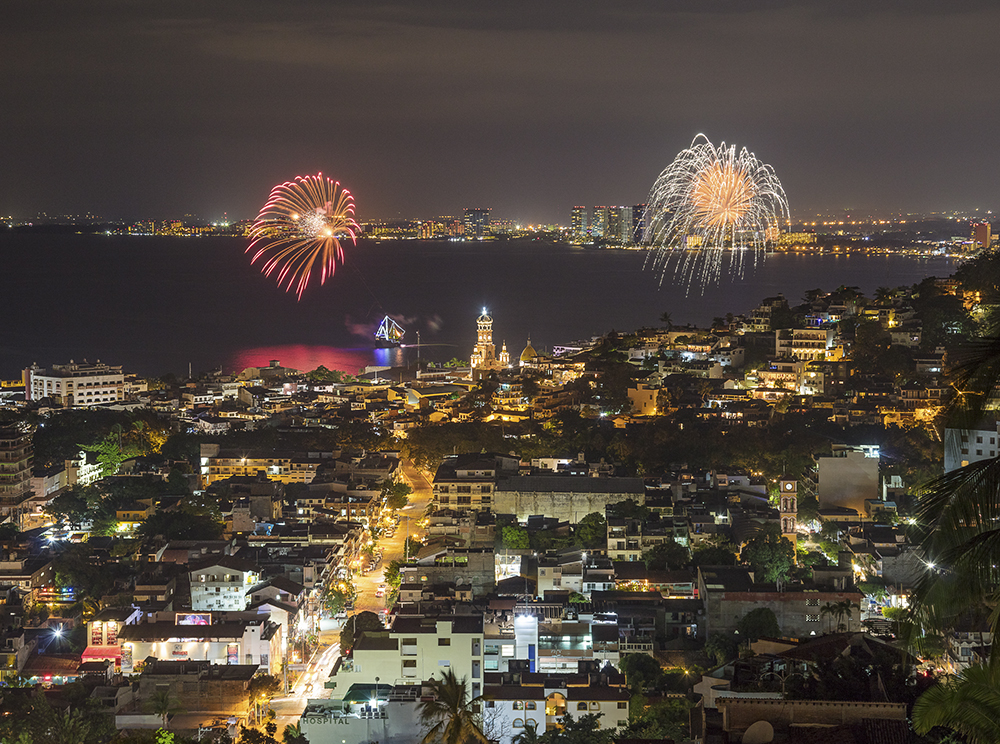
Set Up the Shot
Next you face questions about how to set up the shot. The first element of that is composition. In that respect, you should pay attention to two things.
First, pay attention to the foreground. It is the big variable in your shot. Since the subject is obviously the fireworks and the background is the black sky, the foreground is the only thing worth thinking about. As mentioned previously, the foreground is often the difference between a pedestrian shot and something special. After that, just make sure you do not crop in too tightly. You don’t know exactly where the fireworks are going to go. If the fireworks are cut off the picture is ruined.
Once you have the shot framed, lock down the camera on your tripod. Make sure everything is stable and tight. Consider using mirror lock up (if you are using a DSLR) or, better yet, Live View.
Next, set your focus. Just set it on something far away. It pays to have this set before the fireworks start. Use manual focus if you need to. This is a situation where Back Button Focus pays dividends, since there is no possibility that the camera will try to refocus while you are taking pictures.
After that, just be sure your remote shutter release is ready. Now you are ready for the display to start.
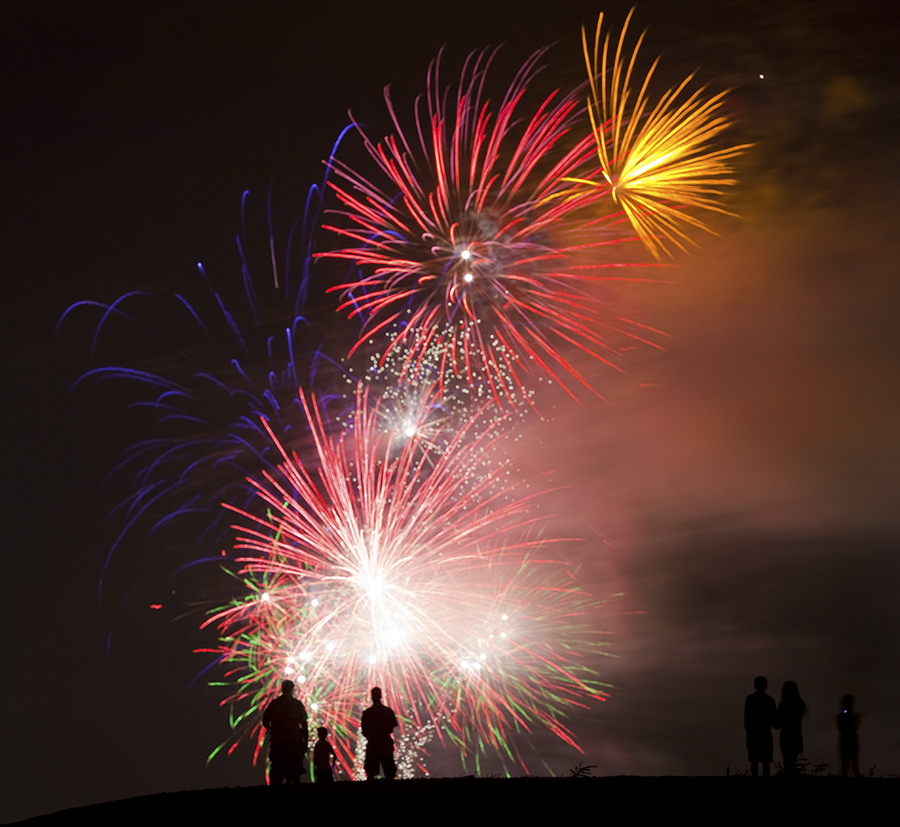
How to Capture the Explosions
Capturing the exploding fireworks is sort of tricky. If you wait to see the explosion before triggering the shutter, then you have missed the first part of the explosion. Who when do you pull the trigger?
Honestly, a lot of times you are going to have to just sit there and click the shutter over and over again without trying to time it too much. The odds are that you’ll get a few good ones. I’m sure that method seems less than ideal, but that is just the way it is done a lot of times.
If you want to try to time the explosions, there are two things to look for. The first is the little white dot you sometimes see when the fireworks are shot into the air. When you see a few of them go up, explosions are imminent so go ahead click the shutter. The other way is to wait for a black sky. When that happens, you can be sure that a few fireworks are about to explode.
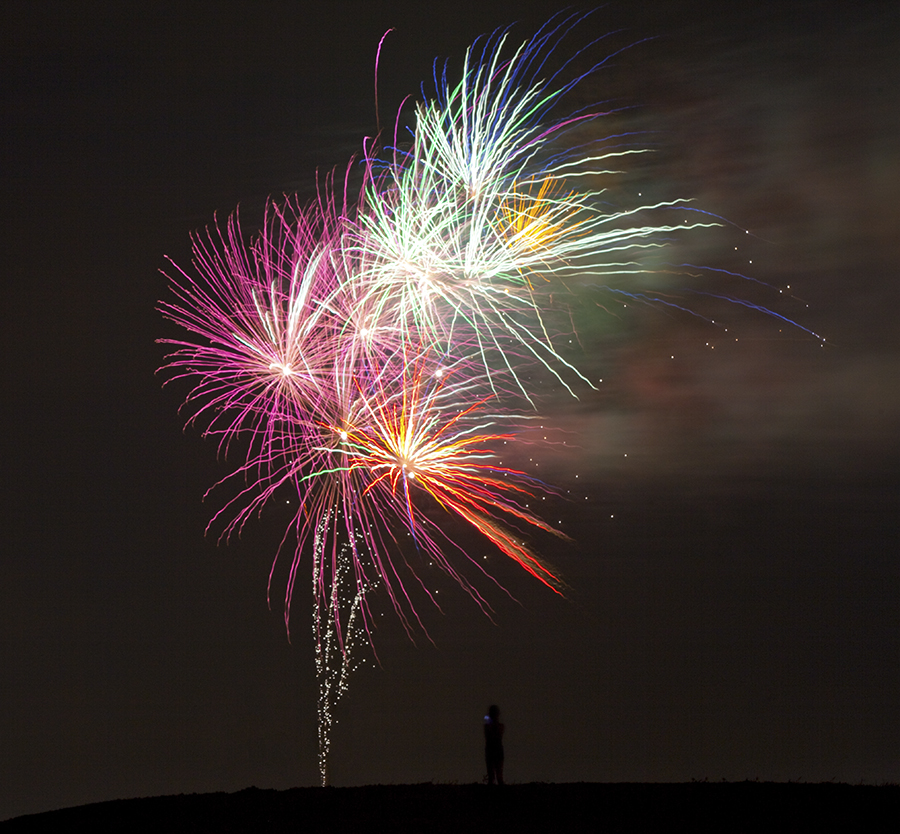
Either way, this process admittedly requires a little bit of luck. You just never know exactly when the fireworks are going to go off.
Processing the Fireworks Photo
Once you have captured your fireworks photos, you can make them look a lot better with just a small amount of post processing. As with any photo, there are a lot of different processing options, and there is no “one size fits all” way to do it. Still, there are three adjustments that will improve the vast majority of your photos. These will work in Lightroom or Photoshop. They are:
1. Pull Down the Highlights: Exploding fireworks are really bright, and they are likely to result in something of a dynamic range problem. Further, the brightness makes them look white and takes away some of the color. Simply pulling down the Highlights slider will go a long way toward improving them.
2. Pull Down the Blacks: Pulling down the Blacks slider will do several things for you. First, it will maintain strong contrast between the black background and the rest of the picture. Secondly, it will make the background more of a blank canvas for you. Finally, it will also tend to reduce the visible digital noise in the picture.
3. Increase the Saturation: A rather strong increase of Vibrance will dramatically improve your fireworks shots. You can also pull up the Saturation slider, but be more judicious about that. If you’d like one color in particular to pop, use the individual color channels in the HSL/Color/B&W panel.
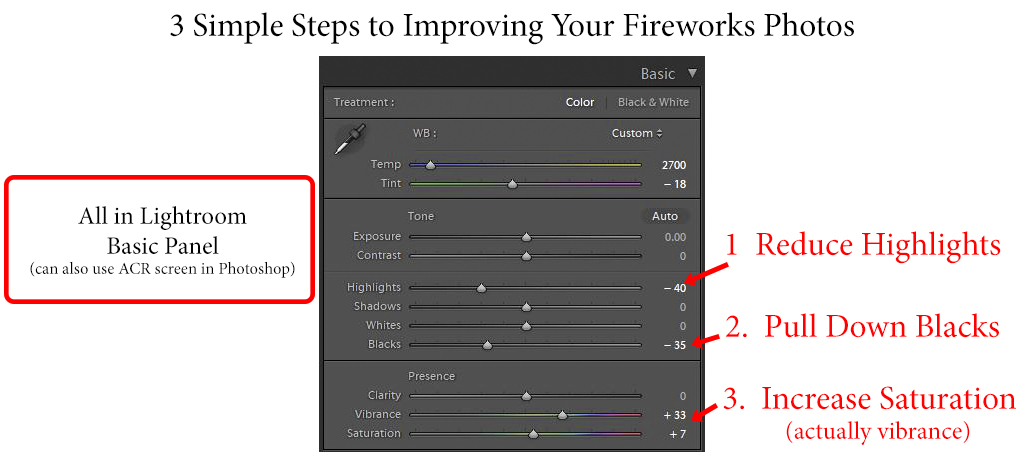
Of course, you can also spend a lot of time processing these pictures if you want. Feel free to apply your normal workflow. But if you want a quick method of making changes, go with those 3 edits.
If you’d like to see an example where I walk through the process very quickly, check out this 2 minute video:
Getting It Right
The key to successful fireworks shots is preparation. Things move fast once the action starts, so you’ll need to have everything prepared ahead of time. If you are making adjustments to your composition, or your focus, or your exposure during the fireworks display, you are missing out. Further, it is important to be ready from the start. As the fireworks display progresses, the sky will get filled with more and more smoke and debris. For this reason, often the best shots are near the beginning of the display. Don’t wait for the finale!

